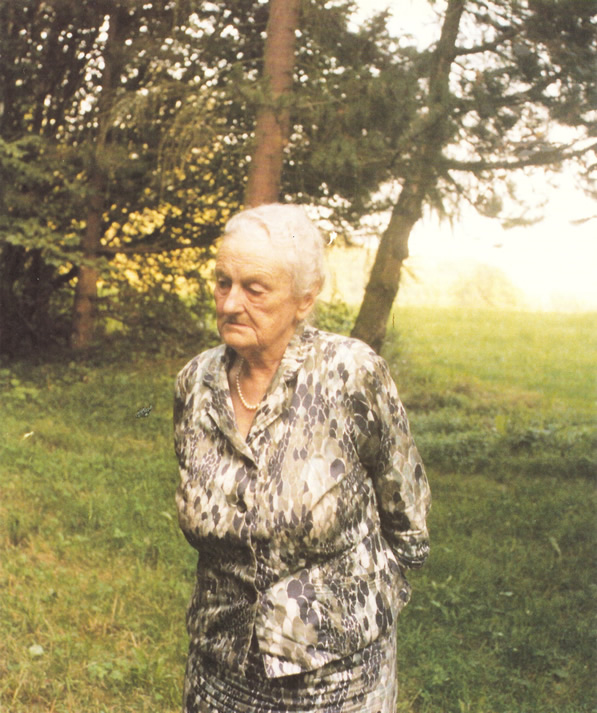


At 93, Barbara Hannah told a friend that she didn't care whether she was remembered or not. And yet - in her work she is so timelessly present that it is impossible not to remember her. Once, sitting on a bench in the mountains, she was talking about death with Jung, who said dryly: "We're sitting here today, and when I'm gone, we'll still be sitting here." Barbara Hannah, too, is also still sitting here beside us. She remains unforgotten.

Barbara Hannah in Bollingen.
Dean L. Frantz, in his moving tribute to his analyst – Barbara Hannah was his pillar of support for decades – gives us insight into her life, telling, among many facts, some anecdotes from her time with Jung, funny and sad ones, experiences with the club and its members, and, of course, of her life with Marie-Louise von Franz. He brings Barbara Hannah to life with his deep respect for a woman who - guided by her dreams - dedicated her life to Jungian psychology, to writing, to her students, analysands and above all to her teacher, C.G. Jung.
Barbara Hannah was born in August 1891 in Brighton, England, the daughter of a minister and later dean of the Anglican Church in Chichester. As the fifth child, she was apparently not overly welcome, as both parents had manifold social obligations and so the children grew up mostly under the care of nannies and governesses. But she owed her love of horses to her father. He put her on a pony when she was only three years old because for a long time she vehemently refused to learn to walk. Her love of animals accompanied her throughout her life and the reader comes across this deep affection in her Cat, Dog and Horse Lectures.1 Her mother died when she was only fifteen years old.
Until the moment when someone put Jung's book on the Psychological Types into the young woman's hands (she had not known Jung before), she had always been searching for her purpose, for the meaning of her life. A year later she discovered an article by Jung in which he wrote about the problems of modern women 2. She was fascinated by his very different way of thinking and looking at things, and she bought and then read all of Jung's books that were available in English at the time. She suspected that life might hold very different possibilities for her than what was generally accepted by the English society in those times.
She was engaged and it was decided that she would marry, have children and care for a family. But when her fiancé had an accident and she was called to his side, she had to make a decision. A seminal dream told her to leave him and travel to Switzerland. Faced with - for a woman – this most difficult dilemma she trusted her inner voice, an exceedingly serious step that gave her life a completely different course: It took her away from her home country. In 1929, it led her to Zurich to meet Jung, the man she said knew more than any other person she had ever known.
Jung, who seldom accepted beginners as analysands, after the first two sessions sent the inquisitive young woman to Tony Wolff, who, after some time, referred her to Peter Baynes.3 In her biography of Jung's life and work, she emphasizes how much Tony Wolff had given her in her analysis. But then an unmistakable dream, a mental picture which revealed her inner conflict, of being torn between her various analysts, in 1931 gave her the longed-for access to analysis with Jung, that was to last for thirty years. In a review, she once said that this had been the greatest happiness of her life.
The relationship with Jung
Barbara Hannah was in the habit of meticulously writing down everything she remembered from her sessions with Jung, as well as from seminars and particularly interesting conversations. Therefore, she was able to draw on a wealth of information when writing her biography of Jung’s life. She vividly describes her first conversation with Jung, which took place on January 14, 1929. She writes: "It is difficult to describe him in words, because his expression altered constantly. He could look very serious, and then something would amuse him, and the sun broke through, so to speak. … He had a habit, however, of looking at people over the rims of his glasses.... He could convey more with an almost imperceptible wink than anyone else I ever saw." But "I felt at one and the same time that Jung could be more direct, even ruthless, than anyone else I had known - and indeed he was, when necessary, even in the first hour – and yet he also obviously had the warmest possible heart and a rare love of humanity."4 Young Barbara felt so close to Jung from the first moment she saw him, that she experienced the strongest "sentiment du déja vu I had ever felt." Still, it took a while before she was accepted into the circle around Jung.
Barbara Hannah never gave up. Dean L. Frantz tells us, that over time, a special, he calls it an enviable, relationship with Jung developed outside of analysis, and she was invited to the Tower a few times. The first time she went there, she was "frankly terrified".5 She writes that she felt transported back to the Middle Ages, because it was so cold and dark inside. Jung’s silent work at the cooking stove that lasted for hours intimidated her. Instinctively, though, she felt that for the sake of her relationship with Jung, she had to submit to this silence. And later, too, she always knew how to adapt to the given situation, to be there at the right moment and to act when and where it was necessary.
Barbara Hannah must have been an excellent driver, because more and more often she was given the role of a chauffeur. She writes: "As I had driven a great deal longer than Toni or either of the Jungs, I found myself their chauffeur in the dark or on the most difficult roads, and thus began to drive Jung about, an activity that was to increase (particularly after he gave up driving himself) right up to one month before his death, and to which I owe a great many of our most interesting conversations."6 This meant a lot to her.
In her conscientious notes in C.G. Jung, His Life and Work In the chapter "Storm Clouds over Europe 1933-1936",7 she calls the rumor, that Jung had any sympathy with the Nazi program, absurd. 8 From the way she describes her own role in this, we can assume that Barbara Hannah was apparently Jung's only confidante in certain situations, for neither his wife nor Toni Wolff had been filled in on the project that should have given hope for an early end to the fighting in World War II. In 1942, some leading psychiatrists from Switzerland and one from Germany who had access to Nazi headquarters asked Jung to help them in an attempt they planned to carry out to reestablish peace. As an unsuspected courier, Barbara Hannah was asked to smuggle important information to England. How hard this task would have been for her is revealed in her book when she writes about her heavy heart.9 We can guess that she would not have been able to return to Switzerland during the war, the country that had become her home. But then the unconscious began to criticize the project in one of her own as well as in Jung's dreams. Jung lost trust in the project and it all came to nothing. This episode shows Barbara Hannah's devotion and absolute loyalty to Jung and his work. Outsiders were often unable to understand the unconditionality of her trust in him.10
Barbara Hannah and Marie-Louise von Franz
In the autumn of 1946 Jung suggested that Marie-Louise von Franz and Barbara Hannah should move into a shared apartment. He argued that it was better for unmarried people to live in one household to experience all the good as well as the bad times of a closer relationship and therewith become better analysts.11 For 25 years, until Barbara Hannah's death, they lived together at Lindenbergstrasse 15 in Küsnacht and in the Tower in Bollingen, that Marie-Louise von Franz had built in 1958. There, on the advice of Esther Harding12 and William H. Kennedy, Barbara Hannah wrote most of her biography of Jung C.G. Jung, His Life and Work. In her book she describes Marie-Louise von Franz as a model and role model for the individuation process. With her common-sense Barbara Hannah helped Marie-Louise von Franz personally a great deal when her animus would once again run away with her. However, in the beginning it was certainly not easy for either of them, because Barbara Hannah was 23 years older than Marie-Louise von Franz and the older woman virtually invited the transference of the negative mother image from which the younger suffered.
Barbara Hannah was well prepared, however, because when she asked Jung why he was so keen on bringing them together, he had mentioned this very negative mother complex. He added: "I have given you someone who will give you a lot of trouble."13 But this was precisely what Marie-Louise von Franz valued so much in her roommate: one could have differences of opinion with an openminded, loyal friend, and get along with her for better or for worse. Barbara Hannah, for her part, showed the highest admiration for Marie-Louise von Franz's professional skills and she spoke of her with great affection. And "[t]hey both had international reputations as analysts and writers."14
The Psychological Club
Barbara Hannah was not yet in Switzerland, at the time Jung founded the Psychological Club in 1916. She arrived in Zürich later, in 1929, but she heard some of its early difficulties from Emma Jung and Toni Wolff.15 Despite these the Psychological Club has survived, and it is amazing how authentical it still is, this because it is being run entirely in the spirit of Jung, which is - as we know - timeless. To this very day the presentations - back then they were called lectures - and discussions are the focus. But besides those, now as then, it is the personal contact between the members as well as the opportunity to meet like-minded people, that is most important. Even at the Apéro, only the name and the culinary customs have changed!
In C.G. Jung, His Life and Work, Barbara Hannah recalls how difficult it had been for her to gain access to the club. It took a while before she was admitted into the circle of the chosen people around Jung. Initially she was not invited to the lectures at the Psychological Club. Jung and Tony Wolff let her know that her German was not good enough to understand the lectures, despite having had a German speaking governess who, in her childhood, looked after her and her siblings for some time. Jung wished to keep the number of club members small and manageable, which is why (alongside quite different reasons she only alludes to) she was not accepted as a member of the club until 1933. Anyone who wanted to join the club as a member had to "pass a tremendous fire of resistance before there was any chance of becoming a statutory guest, much less a member. … [T]he Fierz sons nicknamed Toni 'the club tiger' and I must admit this was an exceedingly apt description."16 The "guardian of the threshold"17as she called Toni Wolff, who was the president at the time, was obviously very capable. But over and over Barbara Hannah emphasizes how extremely important Toni Wolff had been for the Psychological Club. In her extremely honest manner, she also mentions the difficulties that accompanied the start of Toni's presidency: "As an extreme introvert, she found the club difficult at first, but as the years went on she gave more and more of her energy to it and was by far the best president the club ever had. The club also owes more to her than anyone else except Jung himself."18
Some of Barbara Hannah's former analysands or people who were well acquainted with her remember her with gratitude. In the preface to her Lectures on Jung's Aion, Emmanuel Kennedy writes that, apart from Jung, probably no one else dealt more intensively with the opposites in human nature than she did. He assumes that this was the case because her fate forced her to consciously deal with the opposites in her own life. She bowed to this inner necessity and lectured at the Psychological Club and the C.G. Jung Institute in Zurich up to her death. Kennedy goes on saying that Barbara Hannah was known for her simple, feminine, introverted wisdom. And Marion Woodman, then a student at the Jung Institute as well, says of her former analyst how grateful she was for her presence and her feminine ability to live in the moment as it just happened. Alfred Ribi, the psychiatrist and author of the booklet on neuroses from C.G. Jung's point of view, Der normal kranke Mensch19, admired her courage in being able to express her point of view on certain subjects, even when no one dared to speak out. He thinks that the truth - without calculation and know-it-all-ness - has sprung directly from her self.20
Barbara Hannah certainly fulfilled Jung's wish that every human being should try to leave a mark in this world. The individuation process that – in her book Striving Towards Wholeness – she traced in the lives and works of the Brontë children, she herself actively lived. In her striving towards her own wholeness, she is a role model for us all because she showed us the way with unwavering faithfulness.
1 |
Barbara Hannah, The Cat, Dog and Horse Lectures and "The Beyond," Dean L. Frantz, ed, Chiron Publications, 1992. |
2 |
Marie-Louise von Franz, "C.G. Jung und die Probleme der modernen Frau", in: Jungiana Reihe A, Band 6, Verlag Stiftung für Jung'sche Psychologie, Küsnacht, p.9 ff and "Die Frau in Europa", in: GW 10, §§ 236-275. |
3 |
One of the first English doctors to join Jung in Zurich who often assisted him in his practice, see Jung, His Life and Work, by Barbara Hannah, G.B. Putnam's Sons, New York, 1976, p. 140. |
4 |
Barbara Hannah, C.G. Jung, His Life and Work, pp 191-192. |
5 |
Ibid., p.199. |
6 |
Ibid., p.228. |
7 |
Ibid., pp. 209-239. |
8 |
Ibid., pp. 209-239. |
9 |
Barbara Hannah, C.G. Jung, His Life and Work, p. 273. |
10 |
William R. Sanford, in Barbara Hannah, The Inner Journey, Lectures and Essays on Jungian Psychology, p. 150. |
11 |
Barbara Hannah, "In Tune with the Unconscious," in The Cat, Dog and Horse Lectures, p.18. |
12 |
The English physician Esther Harding was one of the founders of the first "Jungian group in New York" and author of several books on Jungian psychology, see C.G. Jung, His Life and Work, p.168. |
13 |
Ibid., p 19. |
14 |
Ibid., pp.18-20. |
15 |
Barbara Hannah, C.G. Jung, His Life and Work, p.197. |
16 |
Ibid., p.202. |
17 |
Ibid., p.201. |
18 |
bid., pp.135, 201. |
19 |
Jungiana, Series B, Vol. 8. |
20 |
William R. Sanford, Alfred Ribi, in Barbara Hannah, The Inner Journey, Lectures and Essays on Jungian Psychology, pp.148-150. |